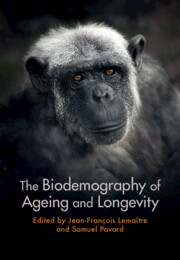Book contents
- The Biodemography of Ageing and Longevity
- The Biodemography of Ageing and Longevity
- Copyright page
- Dedication
- Contents
- Contributors
- Foreword
- Acknowledgements
- 1 The Eternal Youth of Ageing Research
- 2 Theories of Ageing across Ages
- 3 The Diversity of Longevity Metrics
- 4 The Meaning of ‘Exceptional Longevity’
- 5 The Inevitability of Senescence
- 6 The Untapped Potential of Zoo and Aquarium Data for the Comparative Biology of Ageing
- 7 Perspectives in Comparative Biology of Ageing
- 8 An Integrative Approach to Understanding Variation in the Form, Pattern and Pace of Ageing
- 9 Sex Differences in Lifespan, Ageing and Health in the Living World
- 10 Evolution of Human Reproduction, Ageing and Longevity
- 11 Lifespan and Mortality in Hunter-Gatherer and Other Subsistence Populations
- 12 Longevity in Modern Populations
- 13 Health Transition and Population Ageing
- 14 Limit of Human Longevity
- 15 Mortality Modelling at the Oldest Ages in Human Populations
- 16 Lessons from Exceptionally Long-Lived Individuals and Long-Living Families
- 17 Human Populations with Extreme Longevities
- 18 Socio-Economic Consequences of Increased Longevity in Contemporary Populations
- Index
- References
18 - Socio-Economic Consequences of Increased Longevity in Contemporary Populations
Published online by Cambridge University Press: 14 November 2024
- The Biodemography of Ageing and Longevity
- The Biodemography of Ageing and Longevity
- Copyright page
- Dedication
- Contents
- Contributors
- Foreword
- Acknowledgements
- 1 The Eternal Youth of Ageing Research
- 2 Theories of Ageing across Ages
- 3 The Diversity of Longevity Metrics
- 4 The Meaning of ‘Exceptional Longevity’
- 5 The Inevitability of Senescence
- 6 The Untapped Potential of Zoo and Aquarium Data for the Comparative Biology of Ageing
- 7 Perspectives in Comparative Biology of Ageing
- 8 An Integrative Approach to Understanding Variation in the Form, Pattern and Pace of Ageing
- 9 Sex Differences in Lifespan, Ageing and Health in the Living World
- 10 Evolution of Human Reproduction, Ageing and Longevity
- 11 Lifespan and Mortality in Hunter-Gatherer and Other Subsistence Populations
- 12 Longevity in Modern Populations
- 13 Health Transition and Population Ageing
- 14 Limit of Human Longevity
- 15 Mortality Modelling at the Oldest Ages in Human Populations
- 16 Lessons from Exceptionally Long-Lived Individuals and Long-Living Families
- 17 Human Populations with Extreme Longevities
- 18 Socio-Economic Consequences of Increased Longevity in Contemporary Populations
- Index
- References
Summary
Increase in life expectancy will affect future welfare through changes in the stock of human capital and financial wealth. In projecting these changes it is important to differentiate between the direct demographic effect (a change in the population age structure) and the indirect behavioural change (a change in age-specific economic characteristics). Using a multi-country dynamic (general equilibrium) economic model, this chapter assesses the effects of increasing life expectancy on economic growth and inequality in European countries. The economic model accounts for both the direct effect of changes in the age structure of the population, given the economic characteristics, and the indirect effect of population changes on age-specific economic behaviour in a globalized economy. Projections for the period 2020-2100 show that future life expectancy improvements: (1) will have a negative impact on consumption and output per capita; (2) will negatively affect the accumulation of assets (more so in high-income compared to middle-income European countries due to the more generous pension systems in high-income countries); and (3) will lead to an increase in the intergenerational income inequality due to the fall in asset income at old age. However, it also finds that more generous old-age public transfer systems mitigate the negative impact of life expectancy gains on inequality.
Keywords
- Type
- Chapter
- Information
- The Biodemography of Ageing and Longevity , pp. 353 - 374Publisher: Cambridge University PressPrint publication year: 2024

